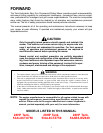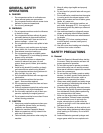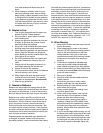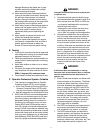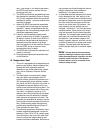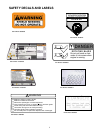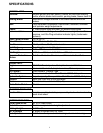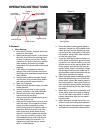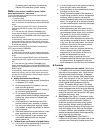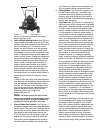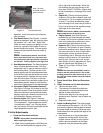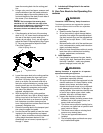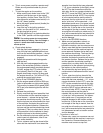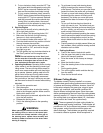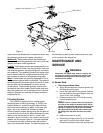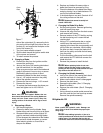11
of grease, grass, and leaves to reduce the
chance of fire and permit proper cooling.
Note: If low traction conditions occur, follow
these procedures for “zero turns”:
To turn clockwise (front of machine moves toward RIGHT)
when traveling FORWARD:
1. Come to a stop,
2. Then slowly move both lap bars rearward (no more
than 1/2 maximum reverse speed) to initiate REVERSE
travel,
3. Then slowly move the LEFT lap bar forward while
maintaining the RIGHT lap bar in the rearward travel
position.
4. To stop the turn and reintiate FORWARD travel,
slowly move the RIGHT lap bar from the REVERSE
travel position to a FORWARD travel position equal t that
of the LEFT lap bar.
5. Alternatively, release both lap bars and the machine
should stop turning, (this is a safety check, the normal
procedure is for the operator to slowly bring the lap bars
to the Neutral psoition).
To turn counter-clockwise (front of machine moves toward
LEFT) when traveling FORWARD:
1. Come to a stop,
2. Then slowly move both lap bars rearward (no more
than 1/2 maximum reverse speed) to initiate REVERSE
travel,
3. Then slowly move the RIGHT lap bar forward while
maintaining the LEFT lap bar in the rearward travel posi-
tion.
4. To stop the turn and reintiate FORWARD travel,
slowly move the LEFT lap bar from the REVERSE travel
position to a FORWARD travel position equal t that of the
RIGHT lap bar.
5. Alternatively, release both lap bars and the machine
should stop turning, (this is a safety check, the normal
procedure is for the operator to slowly bring the lap bars
to the Neutral psoition).
2. Safety Awareness when Mowing
a. Do not operate on steep slopes, those above
15 degrees (27% slope).
b. Avoid turning downhill if possible, if not use
extra care and go slowly.
c. Avoid turning when going downhill, traction is
at a minimum going downhill.
d. Do not operate with discharge side of the
mower toward streets, buildings, playgrounds,
parking lots, other machines, animals, and
other people.
e. Avoid operation or use extreme care if the
traction surface is wet, unstable, or slippery.
f. Use extra care when grass clippings, leaves,
pine needles, or debris are present as traction
can be reduced.
g. Slow-down before turning and come to a com-
plete stop before any zero turn maneuver.
h. Do not stop machine or park machine over
combustible materials such as dry grass,
leaves, debris, etc.
3. To Mow Grass and Produce a Striped Pattern
a. Pick a point on the opposite side of the area to
be mowed (post, tree, shrub, etc.).
b. If on an hillside, start at the bottom so that the
turns are uphill rather than downhill.
c. Align the mower so as to head directly toward
the object on the far side.
d. Slowly increase the speed of the machine to
match cutting conditions, terrain, and operator
familiarity with the controls and keep the
machine headed directly toward the alignment
object. Do not go fast as to reduce cut quality
or to be uncomfortable in controlling the speed
and direction of the machine.
e. When approaching the other end of a strip,
slow down or stop before turning. A U-turn is
recommended unless a zero turn is required.
The speed of a U-turn that will allow for
machine controllability and minimal turf
defacement will be dependent on several fac
-
tors including: the speed of the turn, the radius
of the turn, the tire tread pattern, the traction
coefficient of the tire to the traction surface,
the slope of the traction surface.
f. Remember, a zero turn requires that the for-
ward or reverse travel of the machine be
stopped prior to the initiation of the turn or
severe turf defacement can occur.
g. To prevent rutting or grooving of the turf,
change the direction that the strips are mowed
by approximately 45 degrees the next and
each subsequent time that the area is mowed.
B.Controls
1. Engine ignition and start switch: (See Figure
1.) Located on the instrument housing below the
right side of the operator’s seat. When the key
is inserted and turned clockwise, 45 degrees,
the ignition circuit is closed. When the engine is
“cold”, have the switch in the “on” position until
the glow-plug light goes out. Turning the switch
further against spring pressure starts the
engine. The engine will only start if the blade
clutch switch is in the “off” position, the parking
brake is engaged and the left and right steering
levers are in the neutral position. The key should
always be removed from the switch if the opera
-
tor leaves the mower’s seat.
2. Glow Plugs:
(See Figure 1) Combustion cham-
ber plugs are fitted with the necessary precise tip
protrusion into each combustion chamber, to
enable the sprayed fuel to be properly ignited
during cranking, without causing a significant
drop of combustion efficiency during engine run
-
ning. Glow plugs, due to their high tip tempera-
ture when activated, give satisfactory starting at
ambient temperature-bottom limits approaching
that of other starting-fluid aids.
3.
Engine Throttle Control:
(See Figure 1.)
Located on the left side of the mower next to the
operator’s seat. Moving the throttle control from



